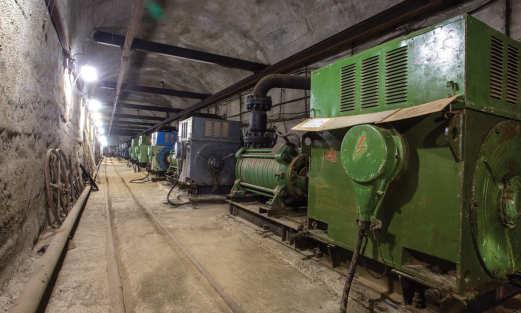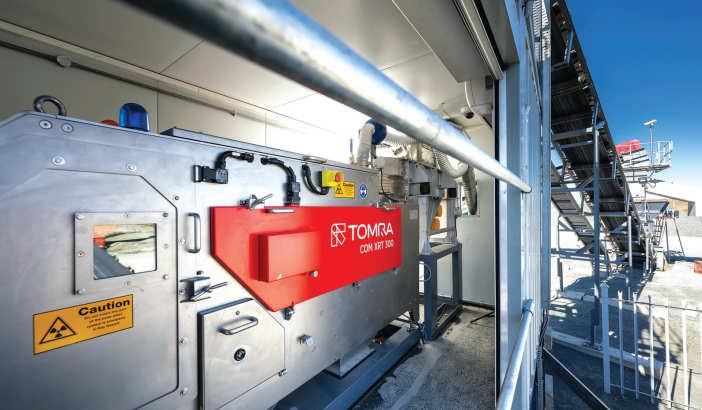
8 minute read
Power in Mining
Sustaining power for mines
Nawa Mutumeno explores how countries and companies are meeting the mining industry’s voracious demand for energy.
Ivanhoe Mines recently announced that the KamoaKakula Mining Complex in the Democratic Republic of Congo (DRC) has set a new quarterly production record in the first quarter of 2022, with 55,602 tonnes of copper in concentrate produced. Kamoa Copper milled 1.08mn ore tonnes during the period at an average feedgrade of 5.91% copper.
In this time, Kamoa-Kakula set a new daily production record with 25,126 tonnes milled and 1,202 tonnes of copper produced.
Management now expects that the early commissioning of the Phase 2 concentrator plant will enable Kamoa Copper to reach the upper end of its 2022 copper production guidance of 290,000 to 340,000 tonnes.
Such impressive figures are attainable on the backdrop of reliable, sustainable power supplies to the mines, ensuring that their heavy machinery, equipment and plants are running smoothly.
Because of the huge amount of work required to produce metals, mining is one of the most energyintensive industries in the world, and accounts for about 5% of global electricity consumption.
“The sheer magnitude of the work done is staggering. For example, Konkola Copper Mines’ Konkola Deep mine on the Zambian Copperbelt runs electrically driven underground pump stations that pump 450mn litres of water to the surface every day – enough to fill 180 Olympic-size swimming pools,” the Zambia Chamber of Mine states.
Also pushing the consumption of electricity in the mines is a move away from diesel-powered machinery to electrically powered ones, which are more efficient and more environmentally friendly.
First Quantum Minerals high-tech US$2.1bn Sentinel Mine in Zambia, uses the world’s large rope-shovels which lift up to 120 tonnes of ore in a single scoop. This electrically powered machine is manufactured by mining-equipment supplier Caterpillar, and is one of three.
The rope shovel’s average power requirements is 11,000 kW – by comparison, the power demand of an average household oven is 2.4 kV. Just one of these giant machinery consumes twice as much electricity in the course of a single day as the average home in the US consumes in an entire year.
“When considered as a portfolio that includes diesel, heavy fuel oil, grid electricity, gas, LNG and other sources, energy can represent up to 30% of a mining company’s total operating costs,” according to professional service firm Deloitte in its 2016 ‘Tracking the Trends’ report.
Factors such as size, design, the grade of copper ore and technological sophistication dictate a mine’s power consumption. These affect how much work – and hence, energy – goes into producing.
Geology matters too: underground mines on the Copperbelt such as Mopani and KCM, have to pump hundreds of millions of litres of water to the surface every day. Keeping the electrically driven pump station running around the clock is the single largest element of their electricity bill.
Mining is one of the most energyintensive industries in the world. Image Credit: Adobe Stock
An industry issue?
In some countries, the industry typically represents a significant –and sometimes the largest – slice of national energy consumption. In Chile, the largest copper producer, mining accounts for more than 20% of total power consumption; in South Africa, the proportion is about 15%; in Australia, it is 9%; while in Zambia, it is more than 50% –reflecting the country’s small installed energy base compared to that of more developed economies.
In countries like Zambia, it is easy to conclude that there could be fewer power outages if it was not for the mining industry’s power consumption. However, this is well within global norms, suggesting the problem lays more within insufficient power supply.
“Zambia’s mines cannot be any less energy-intensive than they already are, and are already running around 70% of their operating power requirements. Reducing power to the mines means reducing production, which negatively impacts employment, export earnings, government tax revenue and economic growth,” the Chamber states.
Power on site
Access to reliable electricity is so important to mining companies that some of them have had to invest in their own power source. Swiss-based Glencore, which ran Mopani until recently, has invested US$368mn into a 450MW hydroelectric plant in the DRC, where power availability is a critical problem.
The decision to build a power plant is factored into the original investment plan, and can easily double the project cost. In the DRC, the rich grade of copper – among the highest in the world – make the huge additional upfront power cost worth the investment.
Zambia’s mines have never had to embark on building their own power stations, because the country already had an abundant source of competitively priced electricity at the time of privatisation in the late 1990s. Further, the country’s copper mining industry is now experiencing declining grades of copper – usually at around 0.5%. Thus, independent power investment in the future is unrealistic. The mines power investments to date have been mainly to supplement the existing infrastructure, e.g. by building transmission lines to connect new mines to the grid.
FQM has built 600 km of powerlines at a cost of about US$100mn, to bring power from the national grid to Sentinel Mine, in Kalumbila.
No matter how it is attained, sustained power supply is an essential stepping stone to the development of mines and will utlimately contribute to national development. ■
No diamond left behind

New technologies around diamond recovery are ensuring that every precious stone is identified and recovered, allowing countries to get the full benefit of their resources.
Diamonds have long been a staple and even a foundation for many of the economies of the African continent. This potentially lucrative sector continues to hold significant potential for countries traditionally operating in this space such as Botswana, South Africa and the DRC as well as emerging nations such as Liberia.
As with all industries, in order to remain on the front foot it is essential for countries and companies to incorporate modern technology to exploit this mineral to its full potential. In order to understand this more, African Review spoke to Corné de Jager, diamond segment manager at TOMRA Mining – one of the world’s leading suppliers of X-Ray Transmission (XRT) diamond recovery technology with a proven track record.
Describing what advantages modern sorting diamond recovery solutions have over conventional methods, de Jager commented, “Diamond bearing ores, such as hard rock Kimberlite, Lamproite and Alluvial deposits, have their own specific processing challenges. Hard rock kimberlite ore requires careful crushing to liberate the diamonds without damaging and breaking them. This liberation process can be complex, energy and water intensive, with high transportation and operating costs. The high waste content means higher energy usage and costs in crushing, and increased risk of diamond breakage. TOMRA’s waste sorting COLOR-NIR technology can remove non-diamond bearing waste material early in the process, making diluted kimberlite deposits more economic to process.
“Alluvial deposits are typically lower in grade with erratic frequencies, which make it a challenge to mine economically. TOMRA’s bulk capacity X-Ray Transmission (XRT) sorters can replace traditional methods such as Rotary Pans, Dense Media Separation (DMS), wet magnetic separation and XRL sorters very effectively. The technology offers extremely high concentration factors, allowing the production of hand sortable, ultra-high diamond by weight concentrates in as little as two stages compared to up to seven required by conventional methods. This reduction of processing stages simplifies the surrounding plant and infrastructure and reduces power and water consumption. This not only makes marginal ores more economically viable to process from both a capital and operating expenditure perspective, but also reduces the environmental impact of the overall process.
“In addition to handling large volumes within limited stages, the XRT sorters operate with high efficiencies and recovery rates. The XRT sorters offer 100% detection of all types of diamonds, irrespective of the diamond’s coating or luminescent profile, and TOMRA guarantees >98% recovery.
“In summary, TOMRA’s modern diamond recovery solution reduces complexity and costs, and maximises efficiency and recovery. By implementing modern methods there is potential for previously deemed non-profitable projects and marginal deposits to be economically viable.”
Image Credit: TOMRA Mining Corné de Jager, diamond segment manager at TOMRA Mining.

Completing the set
The TOMRA COM XRT 300 /FR sorter completes TOMRA’s partnered diamond recovery ecosystem so that the company offers a full solution to sort particles in bulk concentration from +4-100mm and to sort +2-32mm particles in a final recovery, sort house or small capacity exploration application.
“Coupled with all the benefits of cloud computing brought by TOMRA Insight, the COM XRT 300 /FR is the last piece within our recovery process to produce an ultra-high diamond by weight concentrate with an exceptionally low yield,” de Jager remarked. “It is possible to replace multiple sorting stages with a single TOMRA COM XRT 300 /FR sorter all the way down to hand sorting. This means less human error, simplified security requirements and lower security risks.
“The first COM XRT 300 /FR sorter was installed at Letseng Mine in Lesotho, in May 2021. Our customer confirmed that the sorter performed well, with consistent recovery and according to their expectations. The product speaks for itself and we encourage anyone interested in the technology to book a product demonstration at our Test Centers in Johannesburg or Wedel (Hamburg). They can also visit our booth at the Electra Mining Exhibition in Johannesburg from 59 September 2022.”
Changing mentality
While the mining industry has a reputation of being sluggish when it comes to realisation and implementation of new technology, de Jager was optimistic that this was changing. The diamond segment manager said, “There is still large potential and opportunities to adopt these technologies. New technology needs time to permeate into the industry and to become the norm. Major players are embracing it and smaller operations are increasingly showing interest. Awareness is critical and we are actively engaged in updating mining operations on the benefits that modern sorting solutions can offer, which is ultimately to lower costs and increase revenue with reduced environmental impacts.” ■






